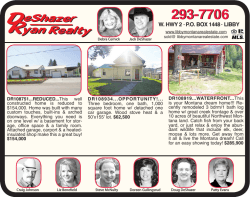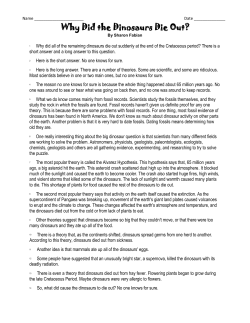
CV and Intercountry Lectureship Questionnaire
Intercountry Lectureship Questionnaire Name: David E. Fastovsky Grant Period: 01/03/2015 – 30/06/2015 U.S. Institution: University of Rhode Island Austrian Host Institution: University of Vienna; Natural History Museum of Vienna e-mail address: defastov@uri.edu Academic Discipline: Geology; Paleontology; Evolutionary Biology Areas of Research: Mesozoic terrestrial paleoenvironments; geobiology of critical intervals; macroevolution, paleobiology and paleoecology of Mesozoic vertebrates Possible Lecture Topics: “Catastrophic Extinction of the Dinosaurs 66 million years ago” Lecturing in the following languages: English preferred; Spanish possible Academic Training and Degrees: B.A., Biology; M.A., Paleontology; Ph.D., Sedimentary Geology Previous Positions: Publications (selected): Book Fastovsky, D.E., and Weishampel, D.B., 2012, Dinosaurs: a Concise Natural History (second edition): Cambridge University Press, Cambridge, 408 p. Journal Articles Ramezani, J., Fastovsky, D.E., and Bowring, S.A., 2014, Revised chronostratigraphy of the lower Chinle Formation strata in Arizona and New Mexico (USA): highprecision U-Pb geochronological constraints on the Late Triassic evolution of dinosaurs: American Journal of Science, v. 314, p. 981 – 1008. Kelley, P.H., Fastovsky, D.E., Wilson, M.A., Laws, R.A., and Raymond, A., 2013, From paleontology to paleobiology: A half-century of progress in understanding life history, in Bickford, M.E., ed., The Web of Geological Sciences: Advances, Impacts, and Interactions: Geological Society of America Special Paper 500, p. 191–232, doi:10.1130/2013.2500(06). Grandpre, R., Schauer, A., Samek, K., Ward, P., and Fastovsky, D., 2013, Testing the terrestrial d13C Cretaceous-Paleogene (K-Pg) chemostratigraphic marker: Palaeogeography, Palaeoclimatology, Palaeoecology, v. 381-382, p. 67 – 75. Tarailo, D., and Fastovsky, D.E., 2012, Post Permo-Triassic terrestrial vertebrate recovery: southwestern United States: Paleobiology, v. 38, p. 644 - 663. Tovar, R.E., Fastovsky, D.E., and Benammi, M., 2012, Calcretas pedogénicas en el Cretáocico Tarde de Michoácan, México: Boletin de la Sociedad Geológica Mexicana, v. 64, p. 61 – 70. Fastovsky, D.E., Weishampel, D.B., Watabe, M., Barbold, R., Tsogtbaatar, Kh., and Narmandakh, P., 2011, A nest of Protoceratops andrewsi (Dinosauria, Ornithischia: Journal of Paleontology, v. 85, p. 1035 - 1041. Fastovsky, D.E., Hermes, O.D., Strater, N.H., Bowring, S.A., Montellano, M., and Hernandez, R., 2005, Pre-Late Jurassic, Fossil-Bearing Volcanic and sedimentary red beds of Huizachal Canyon, Tamaulipas, Mexico, in, Anderson, T.H., Nourse, J.A., and McKee, J.W. (eds.), The Mojave-Sonora Megashear Hypothesis: Development, Assessment, and Alternatives: Geological Society of America Special Paper, no. 393, p. 401 - 426. Fastovsky, D.E., and Sheehan, P.M., 2005, The Extinction of the Dinosaurs in North America: GSA Today, v. 15, p. 4 - 10. Fastovsky, D.E., and Smith, J.B., 2004, Dinosaur paleoecology, in, Weishampel, D.B., Dodson, P., and Osmolska, H., The Dinosauria (2nd Edition): University of California Press, Berkeley, p. 614 - 626. Sheehan, P.M., Fastovsky, D.E., Hoffmann, R.G., Berghaus, C.B., and Gabriel, D.L., 1991, Sudden extinction of the dinosaurs: family-level patterns of ecological diversity during the latest Cretaceous, upper Great Plains, U.S.A.: Science, v. 254, p. 835-839. Fastovsky, D.E., 1987, Paleoenvironments of vertebrate-bearing strata during the Cretaceous-Paleogene transition in eastern Montana and western North Dakota: PALAIOS, v. 2, p. 282-295. McSweeney, K., and Fastovsky, D.E., 1987, Micromorphology of Cretaceous-Paleogene petrosols from eastern Montana and western North Dakota: Geoderma, v. 40, p. 49-63. Fastovsky, D.E., and McSweeney, K., 1987, Paleosols spanning the CretaceousPaleogene transition, eastern Montana and western North Dakota: Geol. Soc. Am. Bull., v. 99, p. 66-77. Laws, R.A., and Fastovsky, D.E., 1987, Characters, stratigraphy, and “depopperate” logic in the reconstruction of phylogeny: PaleoBios, no. 44, 9 p.
© Copyright 2025

















